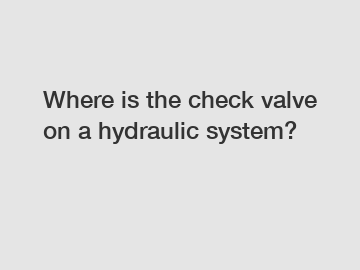Where is the check valve on a hydraulic system?
Link to Huade Hydraulic
Where is the Check Valve on a Hydraulic System?
Hydraulic systems are widely used in various industries for their ability to transfer energy using fluid pressure. These systems rely on a variety of components to function properly, including valves, pumps, and cylinders. One critical component in a hydraulic system is the check valve, which plays a vital role in maintaining the system's efficiency and reliability. In this article, we will explore where the check valve is located within a hydraulic system and its importance in ensuring the system's smooth operation.

Primary Purpose of Check Valves.
A check valve, also known as a non-return valve, is a device that allows fluid flow in one direction while preventing it from flowing in the opposite direction. This feature is essential in hydraulic systems as it helps to control the flow of fluid and prevents backflow, which can cause damage to other components and reduce overall efficiency. Check valves are typically installed in locations where backflow could occur, such as pump outlets or cylinder ports.
Location of Check Valves.
Check valves can be found at different locations within a hydraulic system, depending on the specific application and system design. Here are some common locations where check valves are typically installed:
1. Pump Outlet: One common location for check valves is at the outlet of the hydraulic pump. Placing a check valve here prevents fluid from flowing back into the pump when it is not operating. This is particularly important during startup, as it ensures that the system maintains pressure when the pump is not actively pumping.
2. Cylinder Ports: Check valves are often installed at the ports of hydraulic cylinders. This prevents fluid from flowing back into the cylinder when it is not supposed to, enabling the cylinder to hold its position or prevent unintentional movement caused by external forces.
3. Pressure Lines: In some hydraulic systems, check valves are placed within pressure lines. These valves help to maintain pressure within the system by preventing fluid backflow when the pressure drops, thus protecting other components from damage.
Importance of Check Valves.
Check valves play a crucial role in maintaining the overall efficiency and reliability of hydraulic systems. Their presence helps to prevent fluid backflow, which can damage pumps, cause cylinder drift, or lead to inefficient operation. By ensuring that fluid flows in the desired direction, check valves enable the system to perform optimally and prolong the lifespan of other components.
In summary, check valves are essential components of hydraulic systems that are responsible for controlling the flow of fluid and preventing backflow. These valves can be found at various locations within a hydraulic system, such as the pump outlet, cylinder ports, or pressure lines. Their proper placement and operation are crucial for maintaining the smooth functioning of the system and preventing potential damage. If you have any further questions about check valves or hydraulic systems in general, please do not hesitate to contact us.
Closing paragraph: If you require additional information about the check valves in hydraulic systems or have any other queries related to hydraulic systems, please feel free to contact us. Our team of experts is always ready to assist you and provide the necessary support for your hydraulic system needs.
Please visit our website for more information on this topic.
Are you interested in learning more about two way flow control valve supplier? Contact us today to secure an expert consultation!



